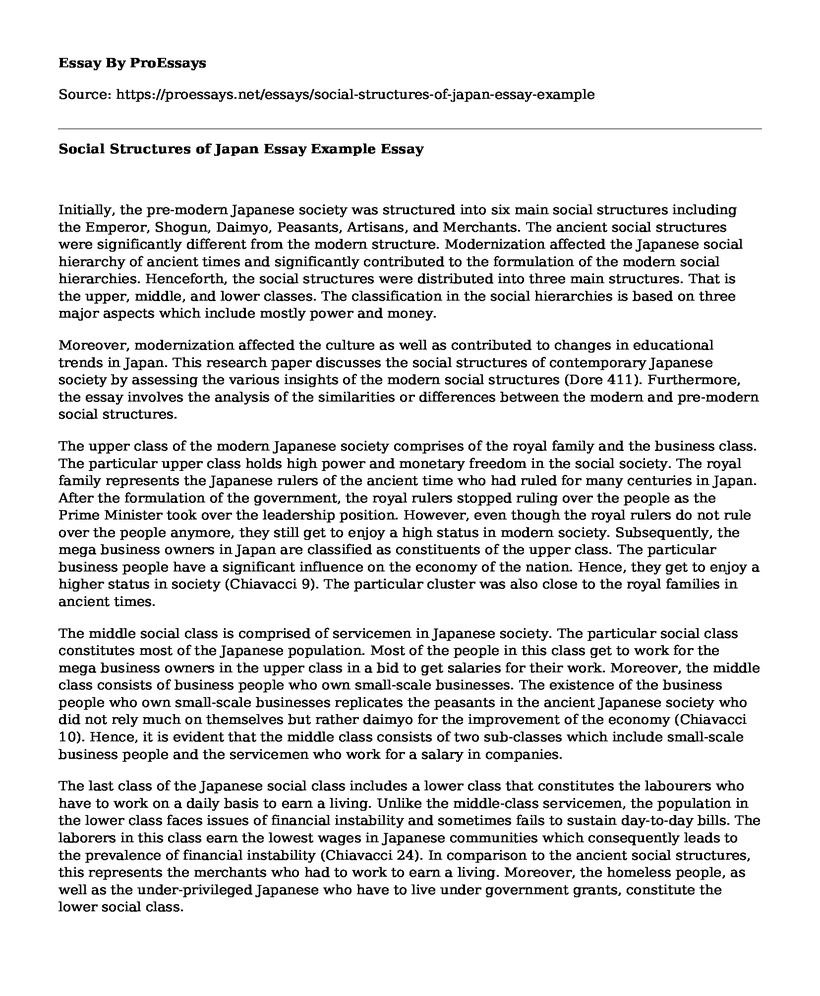Initially, the pre-modern Japanese society was structured into six main social structures including the Emperor, Shogun, Daimyo, Peasants, Artisans, and Merchants. The ancient social structures were significantly different from the modern structure. Modernization affected the Japanese social hierarchy of ancient times and significantly contributed to the formulation of the modern social hierarchies. Henceforth, the social structures were distributed into three main structures. That is the upper, middle, and lower classes. The classification in the social hierarchies is based on three major aspects which include mostly power and money.
Moreover, modernization affected the culture as well as contributed to changes in educational trends in Japan. This research paper discusses the social structures of contemporary Japanese society by assessing the various insights of the modern social structures (Dore 411). Furthermore, the essay involves the analysis of the similarities or differences between the modern and pre-modern social structures.
The upper class of the modern Japanese society comprises of the royal family and the business class. The particular upper class holds high power and monetary freedom in the social society. The royal family represents the Japanese rulers of the ancient time who had ruled for many centuries in Japan. After the formulation of the government, the royal rulers stopped ruling over the people as the Prime Minister took over the leadership position. However, even though the royal rulers do not rule over the people anymore, they still get to enjoy a high status in modern society. Subsequently, the mega business owners in Japan are classified as constituents of the upper class. The particular business people have a significant influence on the economy of the nation. Hence, they get to enjoy a higher status in society (Chiavacci 9). The particular cluster was also close to the royal families in ancient times.
The middle social class is comprised of servicemen in Japanese society. The particular social class constitutes most of the Japanese population. Most of the people in this class get to work for the mega business owners in the upper class in a bid to get salaries for their work. Moreover, the middle class consists of business people who own small-scale businesses. The existence of the business people who own small-scale businesses replicates the peasants in the ancient Japanese society who did not rely much on themselves but rather daimyo for the improvement of the economy (Chiavacci 10). Hence, it is evident that the middle class consists of two sub-classes which include small-scale business people and the servicemen who work for a salary in companies.
The last class of the Japanese social class includes a lower class that constitutes the labourers who have to work on a daily basis to earn a living. Unlike the middle-class servicemen, the population in the lower class faces issues of financial instability and sometimes fails to sustain day-to-day bills. The laborers in this class earn the lowest wages in Japanese communities which consequently leads to the prevalence of financial instability (Chiavacci 24). In comparison to the ancient social structures, this represents the merchants who had to work to earn a living. Moreover, the homeless people, as well as the under-privileged Japanese who have to live under government grants, constitute the lower social class.
Works Cited
Chiavacci, David. "From class struggle to general middle-class society to divided society: Societal models of inequality in postwar Japan." Social Science Japan Journal 11.1 (2008): 5-27.
Dore, Ronald Philip. Aspects of social change in modern Japan. Vol. 1352. Princeton University Press, 2015.
Cite this page
Social Structures of Japan Essay Example. (2022, Oct 08). Retrieved from https://proessays.net/essays/social-structures-of-japan-essay-example
If you are the original author of this essay and no longer wish to have it published on the ProEssays website, please click below to request its removal:
- The Harmful Myths Associated with American Asians - Essay Sample
- Virtual Communities Research Paper Example
- Essay Sample on Cooperation of States
- Essay Sample on Dishonesty in Present Day Society
- Paper Example on US-China Trade War: Impact on Spirits Industry
- Paper Example on African Americans' Fight for Equality: A Historical Overview
- Gender Roles in Narratives - Essay Sample







